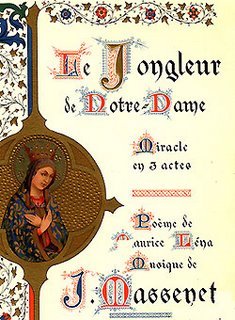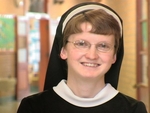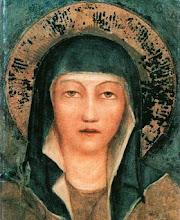

Happy Feast of the Immaculate Conception!!!!!
One year ago, the Knights of Immaculata at Notre Dame held a Latin mass and afterwards had a ceremony for those who wished to consecrate themselves to Mary. Because I’ve never been very good at consistently keeping up with traditional Marian devotions such as the Rosary, I figured that publicly consecrating myself to the Virgin would give me a greater incentive to say my rosary/crown each day. Needless to say, I fell extremely short of meeting my goal of saying a daily rosary….in fact, I’m lucky if I remember to say one rosary per week. Because it’s the one-year anniversary of my consecration to Mary, I was ruminating yesterday on my failure to live up to my promise and I wound up getting down on myself about not saying my rosary.
A few moments later, it occurred to me that God wants us to regard Mary as our true Mother and we as Her little children. I thought about my own childhood and remembered how happy my own mother was when I drew little pictures for her. Indeed, the slapdash pictures that I drew weren’t pieces of art by any standard….but they made my mom happier than any artist’s piece would have, because they were drawn out of love by her own daughter. Nor did my mom expect that I draw a picture every single day or reprimand me when I didn’t have anything for her….she loved me no matter what. Just like an earthly mother, Mary completely loves us regardless of whether we say the rosary every day, once a month, or never say it at all. However, it gives Mary great joy when we do offer gifts of prayer to her. Just as earthly mothers lovingly accept a child’s scribbles and stick figures, our heavenly Mother joyfully takes our prayers and treasures them in Her heart, no matter how humble those prayers might be.
Following from that theme, I’d like to share with you all a beautiful story about Our Lady’s acceptance of whatever we have to offer her. The story, “Le Jongeleur de Notre Dame” (“Our Lady’s Juggler”), is based on a 12th-Century French legend….I’m sure St. Colette and St. Therese were both very familiar with the story.
The story was adapted many times and also made into an opera.
Here is a summary of the opera, which has a slightly different plot than the following story :
Our Lady's Juggler
By Anatole France
In the days of King Louis there lived a poor juggler by the name of Barnabas, a native of Compiègne, who wandered from city to city performing tricks of skill and prowess.
On fair days he would lay down in the public square a worn and aged carpet, and after having attracted a group of children and idlers by certain amusing remarks which he had learned from an old juggler, and which he invariably repeated in the same fashion without altering a word, he would assume the strangest postures, and balance a pewter plate on the tip of his nose. At first the crowd regarded him with indifference, but when, with his hands and head on the ground he threw into the air and caught with his feet six copper balls that glittered in the sunlight, or when, throwing himself back until his neck touched his heels, he assumed the form of a perfect wheel and in that position juggled with twelve knives, he elicited a murmur of admiration from his audience, and small coins rained on his carpet.
Still, Barnabas of Compiègne, like most of those who exist by their accomplishments, had a hard time making a living. Earning his bread by the sweat of his brow, he bore rather more than his share of those miseries we are all heir to through the fault of our Father Adam.
Besides, he was unable to work as much as he would have liked, for in order to exhibit his wonderful talents, he required-like the trees-the warmth of the sun and the heat of the day. In winter time he was no more than a tree stripped of its leaves, in fact, half-dead. The frozen earth was too hard for the juggler. Like the cicada mentioned by Marie de France, he suffered during the bad season from hunger and cold. But, since he had a simple heart, he suffered in silence.
He had never thought much about the origin of wealth nor about the inequality of human conditions. He firmly believed that if this world was evil the next could not but be good, and this faith upheld him. He was not like the clever fellows who sell their souls to the devil; he never took the name of God in vain; he lived the life of an honest man, and though he had no wife of his own, he did not covet his neighbor's, for woman is the enemy of strong men, as we learn by the story of Samson which is written in the Scriptures.
Verily, his mind was not turned in the direction of carnal desire, and it caused him far greater pain to renounce drinking than to forego the pleasure of women. For, though he was not a drunkard, he enjoyed drinking when the weather was warm. He was a good man, fearing God, and devout in his adoration of the Holy Virgin. When he went into a church he never failed to kneel before the image of the Mother of God and to address her with this prayer: "My Lady, watch over my life until it shall please God that I die, and when I am dead, see that I have the joys of Paradise."
One evening, after a day of rain, as he walked sad and bent with his juggling balls under his arm and his knives wrapped up in his old carpet seeking some barn where he might go supperless to bed, he saw a monk going in his direction, and respectfully saluted him. As they were both walking at the same pace, they fell into conversation.
"Friend," said the monk, "how does it happen that you are dressed all in green? Are you perchance going to play the part of the fool in some mystery?"
"No, indeed, father," said Barnabas. "My name is Barnabas, and my business is that of juggler. It would be the finest calling in the world if I could eat every day."
"Friend Barnabas," answered the monk, "be careful what you say. There is no finer calling than the monastic. The priest celebrates the praise of God, the Virgin, and the saints; the life of a monk is a perpetual hymn to the Lord."
And Barnabas replied: "Father, I confess I spoke like an ignorant man. My estate cannot be compared to yours, and though there may be some merit in dancing and balancing a stick with a denier on top of it on the end of your nose, it is in no wise comparable to your merit. Father, I wish I might, like you, sing the Office every day, especially the Office of the Very Holy Virgin, to whom I am specially and piously devoted. I would willingly give up the art by which I am known from Soissons to Beauvais, in more than six hundred cities and villages, in order to enter the monastic life."
The monk was touched by the simplicity of the juggler, and as he was not lacking in discernment, he recognized in Barnabas one of those well-disposed men of whom Our Lord has said, "Let peace be with them on earth." And he made answer therefore:
"Friend Barnabas, come with me and I will see that you enter the monastery of which I am the Prior. He who led Mary the Egyptian through the desert put me across your path in order that I might lead you to salvation." Thus did Barnabas become a monk. In the monastery which he entered, the monks celebrated most magnificently the cult of the Holy Virgin, each of them bringing to her service all the knowledge and skill which God had given him.
The Prior, for his part, wrote books, setting forth, according to the rules of scholasticism, all the virtues of the Mother of God. Brother Maurice copied these treatises with a cunning hand on pages of parchment, while Brother Alèsandre decorated them with delicate miniatures representing the Queen of Heaven seated on the throne of Solomon, with four lions on guard at the foot of it. Around her head, which was encircled by a halo, flew seven doves, the seven gifts of the Holy Spirit: fear, piety, knowledge, power, judgment, intelligence, and wisdom. With her were six golden-haired virgins: Humility, Prudence, Retirement, Respect, Virginity, and Obedience. At her feet two little figures, shining white and quite naked, stood in suppliant attitudes. They were souls imploring, not in vain, Her all-powerful intercession for their salvation. On another page Brother Aléxandre depicted Eve in the presence of Mary, that one might see at the same time sin and its redemption, woman humiliated, and the Virgin exalted. Among the other much-prized pictures in his book were the Well of Living Waters, the Fountain, the Lily, the Moon, the Sun, and the Closed Garden, of which much is said in the Canticle; the Gate of Heaven and the City of God. These were all images of the Virgin.
Brother Marbode, too, was one of the cherished children of Mary. He was ever busy cutting images of stone, so that his beard, his eyebrows and his hair were white with the dust, and his eyes perpetually swollen and full of tears. But he was a hardy and a happy man in his old age, and there was no doubt that the Queen of Paradise watched over the declining days of Her child. Marbode represented Her seated in a pulpit, Her forehead encircled by a halo, with an orb of pearls. He was at great pains to make the folds of Her robe cover the feet of Her of whom the prophet has said, "My beloved is like a closed garden."
At times he represented Her as a graceful child, and Her image seemed to say, "Lord, Thou art My Lord!" There were also in the Monastery poets who composed prose writings in Latin and hymns in honor of the Most Gracious Virgin Mary; there was, indeed, one among them-a Picard-who translated the Miracles of Our Lady into rimed verses in the vulgar tongue.
Perceiving so great a competition in praise and so fine a harvest of good works, Barnabas fell to lamenting his ignorance and simplicity.
"Alas!" he sighed as he walked by himself one day in the little garden shaded by the Monastery wall, "I am so unhappy because I cannot, like my brothers, give worthy praise to the Holy Mother of God to whom I have consecrated all the love in my heart. Alas, I am a stupid fellow, without art, and for your service, Madame, I have no edifying sermons, no fine treatises nicely prepared according to the rules, no beautiful paintings, no cunningly carved statues, and no verses counted off by feet and marching in measure! Alas, I have nothing!"
Thus did he lament and abandon himself to his misery.
One evening when the monks were talking together by way of diversion, he heard one of them tell of a monk who could not recite anything but the Ave Maria. He was scorned for his ignorance, but after he died there sprang from his mouth five roses, in honor of the five letters in the name Maria. Thus was his holiness made manifest.
In listening to this story, Barnabas was conscious once more of the Virgin's beneficence, but he was not consoled by the example of the happy miracle, for his heart was full of zeal and he wanted to celebrate the glory of His Lady in Heaven.
He sought for a way in which to do this, but in vain, and each day brought him greater sorrow, until one morning he sprang joyously from his cot and ran to the chapel, where he remained alone for more than an hour. He returned thither again after dinner, and from that day onward he would go into the chapel every day the moment it was deserted, passing the greater part of the time which the other monks dedicated to the pursuit of the liberal arts and the sciences. He was no longer sad and he sighed no more. But such singular conduct aroused the curiosity of the other monks, and they asked themselves why Brother Barnabas retired alone so often, and the Prior, whose business it was to know everything that his monks were doing, determined to observe Barnabas. One day, therefore, when Barnabas was alone in the chapel, the Prior entered in company with two of the oldest brothers, in order to watch, through the bars of the door, what was going on within.
They saw Barnabas before the image of the Holy Virgin, his head on the floor and his feet in the air, juggling with six copper balls and twelve knives. In honor of the Holy Virgin he was performing the tricks which had in former days brought him the greatest fame. Not understanding that he was thus putting his best talents at the service of the Holy Virgin, the aged brothers cried out against such sacrilege. The Prior knew that Barnabas had a simple soul, but he believed that the man had lost his wits. All three set about to remove Barnabas from the chapel, when they saw the Virgin slowly descend from the altar and, with a fold of her blue mantle, wipe the sweat that streamed over the juggler's forehead.
Then the Prior, bowing his head down to the marble floor, repeated these words:
"Blessed are the pure in heart, for they shall see God."
"Amen," echoed the brothers, bowing down to the floor.















